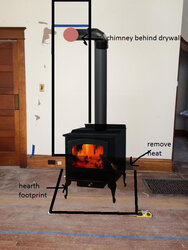here is a bad photoshop attempt to show what im thinking of for my house. nothing is obviously to scale, just to get a general idea. based around an englander 30 NC. the stove will be in the middle of the house.
Hearth pad will pad will be 2x4 with one layer of cement board, one layer micore 300 and then another layer of cement board on top top of that, then will tile with these tiles from lowes:
http://www.lowes.com/pd_177745-12445-BW-37002CS_1z0xzpo 1z0ykxk__?productId=3736483&Ns=p_product_qty_sales_dollar|1&pl=1¤tURL=?Ns=p_product_qty_sales_dollar|1&page=1&facetInfo=Brickweb
Im going to get the rear and side heat shields to reduce clearances.
ill get double wall stove pipe, have a straight piece go up to a 90 where it is level with the hole into the masonry chimney, have another short piece of pipe that leads to a 90, then another short piece that connects to the thimble. The chimney is behind the drywall so ill have to cut through that and knock some out. Any recommendations on a thimble? The chimney is a little offset to the left of the middle of the stove.
Then the thimble will connect to a tee which will be connected to a 6" insulated flex liner (no liner in the chimney currently), the total chimney height of around 20 feet, with a storm cap at the top.
Question:
an old oil furnace is connected to the masonry chimney in the basement, ill obviously remove that, but should i seal that hole back up with brick and mortar?
please give criticism on things i missed or potential problems or ways to do it better. just a rough draft.

Hearth pad will pad will be 2x4 with one layer of cement board, one layer micore 300 and then another layer of cement board on top top of that, then will tile with these tiles from lowes:
http://www.lowes.com/pd_177745-12445-BW-37002CS_1z0xzpo 1z0ykxk__?productId=3736483&Ns=p_product_qty_sales_dollar|1&pl=1¤tURL=?Ns=p_product_qty_sales_dollar|1&page=1&facetInfo=Brickweb
Im going to get the rear and side heat shields to reduce clearances.
ill get double wall stove pipe, have a straight piece go up to a 90 where it is level with the hole into the masonry chimney, have another short piece of pipe that leads to a 90, then another short piece that connects to the thimble. The chimney is behind the drywall so ill have to cut through that and knock some out. Any recommendations on a thimble? The chimney is a little offset to the left of the middle of the stove.
Then the thimble will connect to a tee which will be connected to a 6" insulated flex liner (no liner in the chimney currently), the total chimney height of around 20 feet, with a storm cap at the top.
Question:
an old oil furnace is connected to the masonry chimney in the basement, ill obviously remove that, but should i seal that hole back up with brick and mortar?
please give criticism on things i missed or potential problems or ways to do it better. just a rough draft.

Last edited by a moderator:

